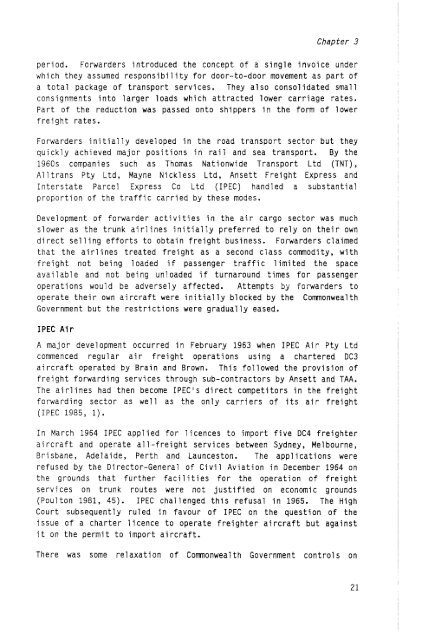Domestic Air Cargo Industry in Australia - Bureau of Infrastructure ...
Domestic Air Cargo Industry in Australia - Bureau of Infrastructure ...
Domestic Air Cargo Industry in Australia - Bureau of Infrastructure ...
You also want an ePaper? Increase the reach of your titles
YUMPU automatically turns print PDFs into web optimized ePapers that Google loves.
Chapter 3period. Forwarders <strong>in</strong>troduced the concept <strong>of</strong> a s<strong>in</strong>gle <strong>in</strong>voice underwhich they assumed responsibility for door-to-door movement as part <strong>of</strong>a total package <strong>of</strong> transport services. They also consolidated smallconsignments <strong>in</strong>to larger loads which attracted lower carriage rates.Part <strong>of</strong> the reduction was passed onto shippers <strong>in</strong> the form <strong>of</strong> lowerfreight rates.Forwarders <strong>in</strong>itially developed <strong>in</strong> the road transport sector but theyquickly achieved major positions <strong>in</strong> rail and sea transport. By the1960s companies such as Thomas Nationwide Transport Ltd (TNT),Alltrans Pty Ltd, Mayne Nickless Ltd, Ansett Freight Express andInterstate Parcel Express CO Ltd (IPEC) handled a substantialproportion <strong>of</strong> the traffic carried by these modes.Development <strong>of</strong> forwarder activities <strong>in</strong> the air cargo sector was muchslower as the trunk air1 <strong>in</strong>es <strong>in</strong>itially preferred to rely on their owndirect sell<strong>in</strong>g efforts to obta<strong>in</strong> freight bus<strong>in</strong>ess. Forwarders claimedthat the airl<strong>in</strong>es treated freight as a second class cornnodity, withfreight not be<strong>in</strong>g loaded if passenger traffic limited the spaceavailable and not be<strong>in</strong>g unloaded if turnaround times for passengeroperations would be adversely affected. Attempts by forwarders tooperate their own aircraft were <strong>in</strong>itially blocked by the CornnonwealthGovernment but the restrictions were gradually eased.IPEC <strong>Air</strong>A major development occurred <strong>in</strong> February 1963 when IPEC <strong>Air</strong> Pty Ltdcommenced regular air freight operations us<strong>in</strong>g a chartered DC3aircraft operated by Bra<strong>in</strong> and Brown. This followed the provision <strong>of</strong>freight forward<strong>in</strong>g services through sub-contractors by Ansett and TAA.The airl<strong>in</strong>es had then become IPEC's direct competitors <strong>in</strong> the freightforward<strong>in</strong>g sector as well as the only carriers <strong>of</strong> its air freight(IPEC 1985, 1).In March 1964 IPEC applied for licences to import five DC4 freighteraircraft and operate all-freight services between Sydney, Melbourne,Brisbane, Adelaide, Perth and Launceston. The applications wererefused by the Director-General <strong>of</strong> Civil Aviation <strong>in</strong> December 1964 onthe grounds that further facilities for theoperation <strong>of</strong> freightservices on trunk routes were not justified on economic grounds(Poulton 1981, 45). IPEC challenged this refusal <strong>in</strong> 1965. The HighCourt subsequently ruled <strong>in</strong> favour <strong>of</strong> IPEC on the question <strong>of</strong> theissue <strong>of</strong> a charter licence to operate freighter aircraft but aga<strong>in</strong>stit on the permit to import aircraft.There was some relaxation <strong>of</strong> Commonwealth Government controlson21
















